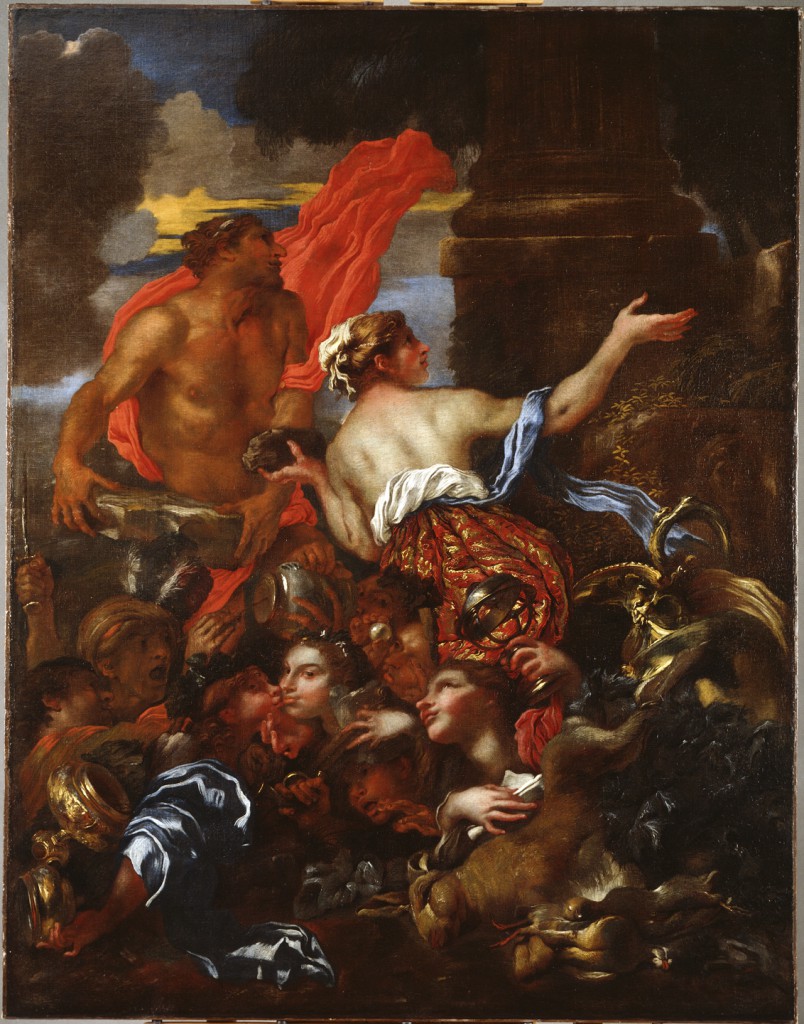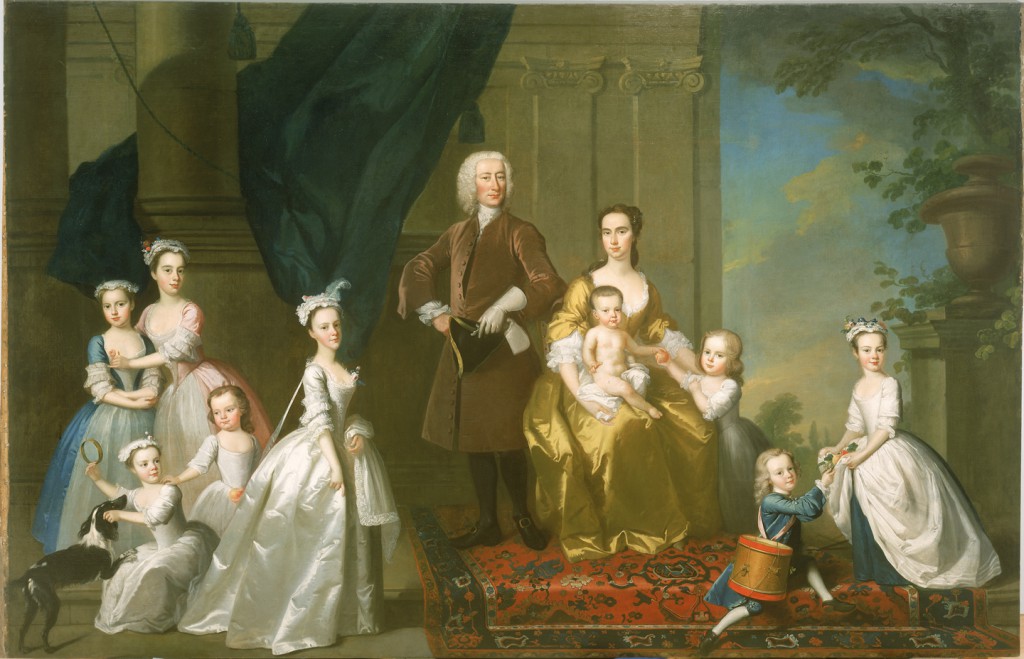Students will examine the artistic characteristics of Deucalion and Pyrrha, compare and contrast a variety of flood stories from around the world, and write a composite story using similar elements of flood stories from around the world as a class.
Students will be able to:
- examine the artistic characteristics of Deucalion and Pyrrha;
- locate Greece on a map of the world;
- locate Italy on a map of the world and identify some defining features of the country;
- compare and contrast a variety of flood stories from around the world; and
- write a flood story composed of similar elements of flood stories from around the world as a class.
Lesson
- Display Deucalion and Pyrrha to the class. Invite the students to look carefully and share what they observe. Who seem to be the main characters? What are they doing? What is the weather? What do you see down at the bottom? Do you see anyone holding anything? What are they holding? What do they think is happening in the painting? What adjectives would you use to describe the painting?
- Share with students that Deucalion and Pyrrha was created by Giovanni Benedetto Castiglione of Genoa, Italy in 1655. Castiglione was an important artist in Italy and used characters from Greek mythology in some of his paintings. Have students locate Italy on a world map and share some quick facts about Italy (e.g., geography, climate, languages, natural resources, government, history) by distributing or displaying information from appropriate websites such as the World Factbook for Italy.
- Read "Deucalion and Pyrrha for Kids" and challenge students to think about the parts of this flood story. Share with the students that this is a Greek myth and encourage them to point out Greece on the map.
- Share with the students that there are many flood stories from around the world. You may want to read one or two stories from each continent, or perhaps focus on stories from cultures which the students have already studies. Pick two or three examples from a collection of Flood Stories from Around the World.
- Ask the students to reflect on the following questions: What similarities and differences do you notice about the flood stories? Why do you think so many different cultures share similar stories? Can you think of any other stories that are similar across cultures and time periods? Record the students’ ideas on a large piece of chart paper or (interactive) whiteboard. Construct a “formula” for flood stories based on students’ responses about similarities.
- Using your formula, write a story composed of the commonalities as a class. Use the following questions as a guide: When does the flood take place? How does the flood happen? Why does the flood happen? Who, if anyone, is saved during the flood? What happens to people and animals during and after the flood?
- Upon completing your composite story, read the story aloud and reflect on how it is similar and different to the story of Deucalion and Pyrrha that you read first. Could you depict it in a similar way? If not, what would you do to change the illustration? How can we learn about different cultures and different times by comparing and contrasting similar types of stories?
Materials
- Lined paper and pen/pencil for each student
- Ability to display information and images from the Internet to students
- Large piece of chart paper and colored markers or (interactive) whiteboard for recording students’ ideas
- Map of the world, visible to all students in the classroom
- One copy of “Deucalion and Pyrrha for Kids”
- About the Art section on Deucalion and Pyrrha
- One color copy of the painting for every four students, or the ability to project the image onto a wall or screen
- Internet access to the following websites
Standards
- Social Studies
- History
- Geography
- Analyze historical sources using tools of a historian
- Become familiar with World geography
- Visual Arts
- Observe and Learn to Comprehend
- Envision and Critique to Reflect
- Language Arts
- Oral Expression and Listening
- Writing and Composition
- Reading for All Purposes
- Collaboration
- Critical Thinking & Reasoning
- Information Literacy
- Invention
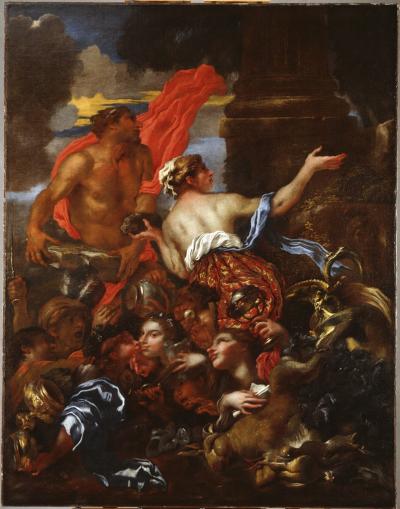
Deucalion and Pyrrha
Giovanni Benedetto Castiglione, Italy
1655
61 in. x 47.5 in.
Funds from T. Edward and Tullah Hanley and Mr.and Mrs. Carl M. Williams by exchange, 1998.39
Photograph © Denver Art Museum 2009. All Rights Reserved.
Born in Genoa, Italy, Giovanni [joe-VAHN-knee] Benedetto Castiglione [cast-eel-lee-OH-nay] was one of the most influential Genoese artists of the 1600s. Castiglione’s eclectic style can be partially attributed to his many teachers and his travels to nearly every major artistic center of Italy. He is known for his prints, monotypes, extraordinary drawings in pen and ink, and oils on paper. The most distinct and praised features of his art are his brilliant colors and highly skilled execution. His subjects were drawn from a variety of sources: the Old Testament, classical mythology, ancient history, and 16th century Italian literature. He received commissions for large altarpieces for churches throughout Italy, as well as for paintings for many major clients. Additionally, he and his workshop produced a number of ready-for-sale works for any number of clients during his lifetime. It might be argued that his work was far better appreciated after his death.
This painting is based on a Greek mythological story called the “Flood of Deucalion,” which comes from the first book of Ovid’s Metamorphosis. The story goes: After the Greek god Zeus witnessed human arrogance and impiety, he decided to destroy the entire human race with an immense flood. Deucalion [do-KAY-lee-on] was warned by his father, the god Prometheus, of the imminent doom and was told to build an ark, which he and his wife Pyrrha [PEER-uh] floated upon for nine days before settling safely on Mount Parnassus. It was now this pious couple’s duty to repopulate the earth, so they went to the oracle of the goddess Themis to learn how to accomplish this. Themis responded, “Depart from my temple, veil your heads, loosen the girdles of your garments, and throw behind you the bones of our great mother.” Unsure of the meaning of this cryptic response, Deucalion suggested that “great mother” implied Mother Earth, and that “the bones” were, in fact, stones. As they threw the stones behind them, Deucalion’s stones turned into men and Pyrrha’s turned into women.
Details
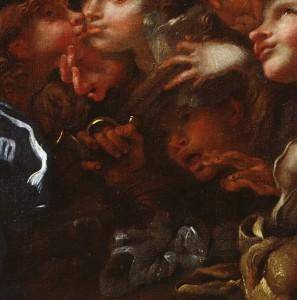
Upper vs. Lower Half
The upper and lower halves of this painting are quite different. Deucalion and Pyrrha are the only figures in the relatively calm upper half, sharing the space with the temple column and the clearing sky. The chaotic lower half is filled with a mass of newly created human beings with no ground line to support them. The figures all churn towards the center of the painting, making it difficult to match faces with limbs.
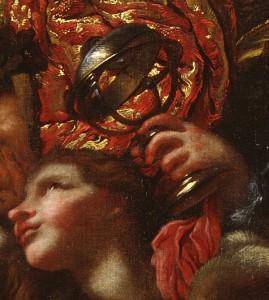
Types of Humanity
When depicting the new human race, Castiglione seems to be more interested in portraying human types rather than portraits of individuals. A few speculations on the depictions: a soldier, a drunk, an artist, lovers, a muse/intellectual, and possibly a scientist.
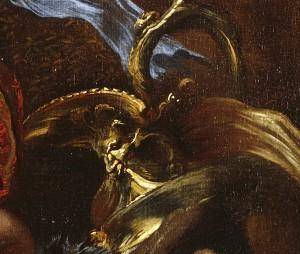
Objects
Scholars suspect that some of the objects depicted in the lower half may be clues to the human types that may have been portrayed. It has also been suggested that the objects allude to the senses: taste, hearing, touch, and sight. The objects include: a dagger (for the soldier), a lidded metal urn (held by one of the lovers), a document (possibly some form of literature for the intellectual), an astrolabe (an astronomical instrument for the scientist), a glass orb, and a hunting horn.
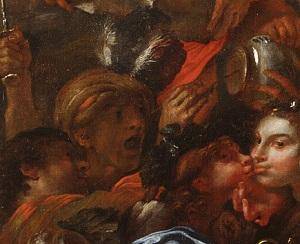
Self-Portrait?
It was not uncommon for an artist during this time to include a picture of himself within a painting. There is one person amid the chaotic mass who seems calm as he reaches out with a paintbrush to sign the underside of a vase. The face of this figure, as well as his hat, resembles Castiglione’s known self-portraits. This hat is consistent with 17th century fashion and differs from the laurel wreaths worn by the others, as if Castiglione has nestled a modern image of himself into an ancient scene.
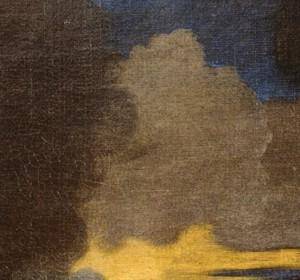
Sky
The stormy skies in the background show evidence of the recent flood that brought Deucalion and Pyrrha to this scene. The darkest clouds seem to be clearing behind them and could be symbolic of the new day of humanity.
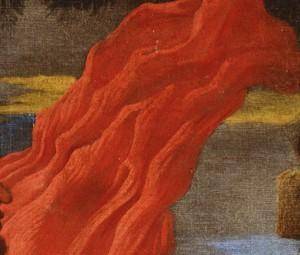
Flaming Color
The name Pyrrha means flaming, flame-colored, orange. Deucalion’s burnt orange robe whirls upwards like a flame and dominates the upper half of the composition. A similar color used on several areas in the lower half unites the two parts of the painting.
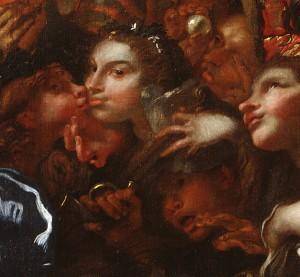
Drama
Castiglione used several strategies to heighten the drama in this painting. He chose bright colors that not only add excitement to the painting but probably also helped when it was hung in a dimly lit room. Dramatic lighting makes spot-lighted figures pop out of the darkened background. Deuacalion and Pyrrha’s arms stir up action with pinwheel motions. The artist has created a turbulent composition in which everything seems to be in motion except for the large sturdy column.
Funding for object education resources provided by a grant from the Morgridge Family Foundation. Additional funding provided by the William Randolph Hearst Endowment for Education Programs, and Xcel Energy Foundation. We thank our colleagues at the University of Denver Morgridge College of Education.
The images on this page are intended for classroom use only and may not be reproduced for other reasons without the permission of the Denver Art Museum. This object may not currently be on display at the museum.
